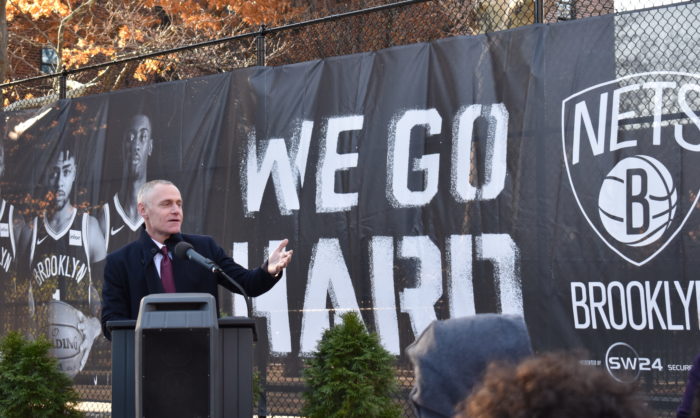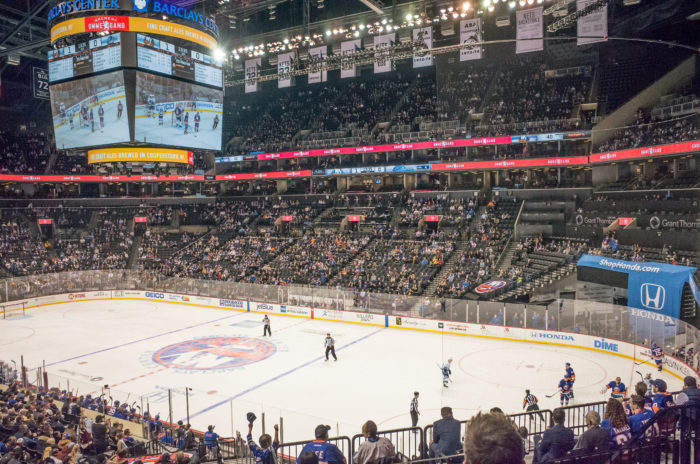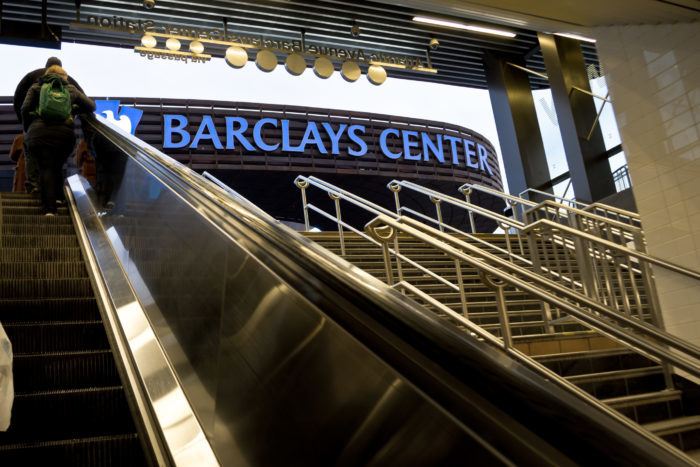When the New York Islanders announced five years ago that they would leave the Long Island suburbs for Brooklyn to share the new Barclays Center with the Brooklyn Nets, the move was hailed by the New York Times as “an unexpectedly rapid vindication” of the arena and the whole Atlantic Yards development project. Said then-Mayor Bloomberg of the struggling hockey team: “Brooklyn, I’m sure, will help them get their mojo back.”
Indeed, half a decade later, the Islanders are a solid hockey team, with a stellar home record and a likely slot in the playoffs. But sellout crowds and financial success have yet to arrive. Now comes a face-off between the team’s owners and the arena’s operating company, Brooklyn Sports & Entertainment (BS&E). The showdown may soon determine whether pro hockey has a future in Brooklyn.
Hoping a new, hockey-centric arena would bring bigger crowds and stronger revenues, the team has proposed building a facility on state-owned land next to the Belmont racetrack, just over the Queens border in Nassau County.
BS&E, for its part, has complicated feelings about the hockey team as a business partner, but seems clearly opposed to the team leaving for a new arena. “I do not think we need another venue, nor do I think the market can support another venue,” Brett Yormark, CEO of BS&E, recently told Pollstar, a concert-industry trade publication.
The problem for the company is that a new arena so close by would not just showcase the Islanders, it would compete for concerts and other events with Barclays and the Nassau Coliseum, both operated by BS&E (owned by Russian billionaire Mikhail Prokhorov). The competition would likely make a challenging situation worse.
At the time Yormark made his comments, the company was coming to grips with disappointing financial results for the arena. Barclays in its last fiscal year—its second with the Islanders–suffered a 39% drop in net revenue, to $28 million, which then dwindled further after paying off construction debt.

Brett Yormark, CEO of Brooklyn Sports & Entertainment, at a public-park dedication last week (Photo by Steve Koepp)
Yes, Barclays remains busy–it sold the seventh-most concert tickets of all the arenas in the world last year, second in the U.S. only to Madison Square Garden, according to Pollstar, a ranking it has maintained this year. Barclays recently welcomed its ten-millionth guest since its opening in 2012. But hosting the Islanders has proven financially treacherous.
The arena company’s recent fiscal-year 2017 financial results, not previously reported in the media, showed net revenues $18 million below estimates in a prospectus shown just last year to arena bond buyers. While the financial report didn’t name a particular cause, ratings agency Moody’s separately blamed lowered revenues and cash flow “caused by the attendance and related ticket sales decline” at Islanders games, plus the arena’s obligation to guarantee payments to the Islanders. The result: “a net loss from Islanders’ related business activities” in the last fiscal year, which Moody’s predicted would persist this season and next unless attendance picks up.
The Belmont Arena Gambit
The stage seems set for a game of arena chicken between Prokhorov’s camp and the Islanders owners, who have the financial backing of big-pocketed allies connected to Madison Square Garden and the Mets-owning Wilpon family. Their proposal for a hockey arena at Belmont is competing with just one other response to a request for proposals from Empire State Development, the state authority that controls the Belmont land: a bid for a soccer stadium from New York City FC. A third bidder just dropped out, likely strengthening the Islanders’ hand. Both bidders are expected to present renderings Sunday, Newsday reported.
Islanders co-owner Jon Ledecky recently hailed a revamped Islanders’ practice facility in East Meadow, Long Island, telling Newsday it was “the same kind of quality of excellence that we want to bring to the Belmont Park project.” But that cost just a few million dollars, not the hundreds of millions involved in building an arena. The Empire State Development is pondering the proposals with no announced decision timetable.
Even as BS&E’s Yormark opposes the Belmont plan, however, his company has shown its disappointment in the Islanders, at least under the current operating agreement. Yormark recently said of hockey in Brooklyn, “The economics just don’t work.” (Ledecky retorted: “I guess he’s saying the people on their side didn’t make a good deal.”) In January, Bloomberg reported that Barclays was “dumping” the Islanders, attributing that notion to “people familiar with the facility’s financials,” which may have been a tactical leak.
Not the Perfect Home for Hockey
The Barclays Center, downsized during the recession to focus on basketball (and save money) and with no parking lots for tailgating, is less than ideal as a hockey venue. The arena was already under construction when–after Nassau County voters in 2011 voted down a proposal to build a new arena–the Islanders started looking for a new home. The seating capacity at Barclays for hockey is 15,795, the second-smallest home venue in the National Hockey League. Four hundred of those seats have obstructed views of the rink, and far more have limited views, which have drawn scorn from fans. The awkward layout means the scoreboard is off-center and one end of the arena can look empty because fans shun the seats.
The Islanders’ first season, though bumpy, seemed promising. A 2016 consultant’s report aimed at arena-bond buyers said Barclays’ second anchor tenant added “incremental suite, sponsorship and concession income” and that the arrival of the Islanders “has been beneficial for the arena.”
Apparently, the boost lasted just one season, as the Islanders—with a proud history at Long Island’s Nassau Coliseum—haven’t established themselves the way the NBA’s Nets rebooted in Brooklyn after the move from New Jersey. Moody’s cited the “Islanders ownership’s inability to add to the existing fan base and build their brand in Brooklyn,” but that’s also the responsibility of BS&E, which has faced criticism from fans for failing to do just that. Though promising Brooklyn as “Tradition’s New Home,” arena managers proceeded awkwardly, for example, replacing the longstanding post-goal foghorn sound with a subway horn, then reversing course.
The Islanders’ average regular-season attendance dipped only slightly from 13,626 in their first year to 13,101 last year, but both were third-worst in the NHL. The Islanders missed the playoffs by a hair, after two previous post-season berths. Moody’s said the failure to build a brand in Brooklyn has hindered revenues from ticket sales, sponsorships, premium seating, and concessions.
This season, announced attendance over the first eleven home games averaged just 11,685, worst in the league. Though low early-season attendance is typical–last year, the Islanders averaged 12,379 after ten games—another downtick may be looming. When this reporter attended a game last Tuesday, the Islanders drew an enthusiastic but small announced crowd of 11,194. Hockey fans do apparently spend money inside: along with the regular concession stands and carts, individual vendors were stationed throughout the downstairs concourse to sell cans of beer from crates. (One vendor said hockey attendees drink “five times” more beer than basketball fans–not a scientific study, but you get the idea.)
But clearly there’s room for more fans. Six hours before puck drop Tuesday, ESPN’s schedule page indicated 3,361 tickets available, starting at $5, a lower price and larger ticket pool than in any other NHL game last week. This reporter paid a re-seller $15 for a ticket with a $35 face value.
Can This Partnership Be Saved?
In an unusual arrangement for a sports team and its landlord, Barclays runs the business side, including marketing, and keeps revenue from ticketing, sponsorships, and advertising, then pays the Islanders according to undisclosed guarantees. While reports suggested Barclays would pay $53.5 million annually, that left wiggle room regarding expenses. Barclays paid the Islanders $37.5 million in fiscal-year 2016 and $39.8 million in fiscal-year 2017, according to its financial reports.

At an Islanders game last Tuesday, fans were enthusiastic but thousands of seats were empty
The clock is ticking: the Islanders and the arena have until Jan. 1 to resolve “good faith discussions” to modify their 25-year deal, as Newsday noted. If they’re at an impasse, they can re-up the current terms—unlikely—or declare an opt-out by Jan. 30.
By the terms of the deal, the Islanders could jump before they’re pushed. The team could leave after this season or next, though Ledecky has said they’ll stay for a fourth year. Barclays, for its part, can eject the Islanders only after that fourth season. A resolution regarding the Islanders’ fifth season–a severed relationship? a short-term revision or extension?–may come before the fate of Belmont is known.
While neither Ledecky nor the NHL have expressed enthusiasm about the the Nassau Coliseum, Yormark has pushed it as the Islanders’ permanent home, while also saying he has given the Islanders owners “optionality” for playing at Barclays or some combination of the two. The Nassau facility has physical limitations, including tight concourses and no mass transit, and was downsized to 13,000 seats for hockey, but a sell-out exhibition game this year signaled abiding fan interest.
If the Islanders do win the Belmont bid, they’ll need a place to play during construction, so Barclays-plus-Nassau might surface as a possibility. If the Islanders don’t get Belmont, Ledecky has said he has no Plan B. If the team seeks to stay in the New York area, with their fan base and valuable local TV contract, Yormark likely has leverage to negotiate a better deal at Barclays and perhaps push the team to play some games at Nassau.
But if the Belmont proposal fails, Newsday‘s Islanders beat writer Arthur Staple thinks the team must consider leaving New York. Indeed, The Athletic website recently reported that NHL Commissioner Gary Bettman–who has three teams, including the Islanders, looking for venues–recently met with the owner of the Houston Rockets basketball team, who’d like to bring a team to its arena, which could seat 17,800 for hockey. (There are also arenas available in Seattle and Quebec City.) But Bettman’s first choice for the Islanders is Belmont, Newsday reported.
The Bid to Keep the Team
BS&E may be able to make Barclays a somewhat better home for hockey. A case in point: Barclays seems to be responding to complaints last year about inconsistent and choppy ice, attributed to the arena’s use of PVC piping for the chilling system rather than metal, which other arenas use. “If the relationship with the Islanders extends, we’re more than willing and able to accommodate them with copper piping,” Yormark said in June. In the meantime, players say the ice is better, apparently because the arena is being kept chillier, according to EliteSportsNY.
Barclays may not love the Islanders, but it likely fears a competing arena even more. A new Belmont facility, complete with a Long Island Rail Road stop and big parking lot for tailgating, could set up a battle royale in which the projected 150 new events at the arena would cut into the schedules at Barclays and Nassau. That hurts Prokhorov’s plan–he’s also renovating Webster Hall in Manhattan and the Paramount Theatre in Brooklyn–to be an entertainment colossus. (He’s divesting himself from basketball; Joseph Tsai, a tycoon in Chinese e-commerce, has agreed to buy 49% of the Nets, with an option to buy it all, in a deal that values the team at $2.3 billion.)

The view of Barclays Center as commuters emerge from the subway station on its front plaza (Photo by iStock/Getty Images)
As for the Islanders, though Ledecky calls Belmont the team’s “best home and the only home,” they should be careful what they wish for. Surely the new arena could draw more hockey fans. But the arena builders’ profits also must pay off construction.
One lesson from Barclays, which in its first year made what the Wall Street Journal called “generous deals to woo big names,” was that the buzz exceeded the profits. “The true test is years away,” concert promoter Jim Glancy told the New York Times in 2012, given that the arena honeymoon coincided with renovations at Madison Square Garden.
Another lesson: enthusiastic predictions and market studies commissioned by developers don’t necessarily hold up. As noted, Barclays’ fiscal 2017 net revenue (revenue minus expenses) fell to $28 million, barely half the $55 million that the arena’s developer, Forest City Ratner, predicted would be reached once the Islanders arrived and provided revenue stability. The latter estimate had been steadily downgraded from what now seems to have been a vastly over-optimistic $70 million.
The Debt Factor
What’s crucial to Barclays is keeping its financial results healthy enough to satisfy its bondholders. Prokhorov refinanced the arena’s bonds last year, securing a lower interest rate and smaller annual payments, but continued disappointing financial performance poses dangers for BS&E.
When the arena bonds were refinanced, Moody’s in August 2016 predicted that the debt service coverage ratio (DSCR)—a common metric used to describe the revenues available to pay off bonds—would reach 1.9x, or nearly twice the money needed. If it fell below 1.45x “on a sustained basis,” Moody’s said that could trigger a downgrade from Baa3—the lowest investment-grade rating—to “junk” status, which signals much higher risk. (BS&E declined to comment on the Moody’s analysis and other questions.)
Last year’s DSCR sunk to 1.31x and Moody’s predicts a further decline to 1.07x this fiscal year. For now, the arena does have cash reserves to survive lean years, Moody’s says. But if a downgrade comes, that could trigger sales of Barclays bonds by institutions that aren’t allowed to own junk bonds, and could raise the cost of potential future financing. Potential causes for a downgrade to “junk,” according to Moody’s, would include losing the Islanders without booking enough replacement events, or even keeping the Islanders and failing to lift revenues.
In other words, Yormark is not just fighting off a rival venue. He must also forge more certainty for an arena whose finances are more wobbly than its hulking steel edifice would suggest.